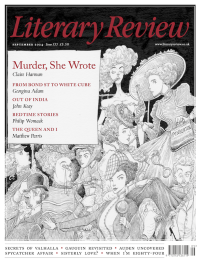William Whyte
Rich in Meaning
Money Talks: Art, Society & Power
Ashmolean Museum, Oxford, until 5 January 2025
Money isn’t what it was. Only about 14 per cent of transactions in the UK now involve cash. In Norway, the figure is as low as 3 per cent. It is widely reckoned that Sweden, the first European country to issue banknotes, will become the first in the world to cease printing them. Next door, the state bank of Finland predicts that the country will be totally cashless by 2029. Blockchains, non-fungible tokens, digital wallets and simple chip-and-pin debit cards – all of these technologies seem to threaten something that was, until only recently, an apparently fundamental part of modern life. Paper money and metallic coinage seem more vulnerable than we might ever have expected.
It’s a good time to reflect on what money once meant and what it might mean in the future. Visitors to the Ashmolean’s new exhibition are left in no doubt that it matters. At the entrance, they are greeted by two huge assertions of that fact. On the right is a two-metre-high gold dollar sign painted by Andy Warhol. ‘Making money is art and working is art and good business is the best art’, reads one of his obiter dicta beside it. On the left is an even more substantial statement. Unicode, by Indian-born artist Tallur L N, is a big ball of concrete encircled by a gilded flaming halo. It looks like an altarpiece for devotees of a meteor-worshipping sect. In fact, it’s a play on the Nataraja, a representation of the god Shiva dancing, one of the most famous motifs in Indian art. As one leans in to look, it becomes clear that the rough surface of the concrete is pitted with coins.
Looking closely is a useful habit for the visitor to get accustomed to. After these two big opening pieces, most of the exhibition is made up of much smaller things, both historical artefacts and contemporary artworks. The one major exception – the seemingly obligatory piece by Grayson Perry, standard issue

Sign Up to our newsletter
Receive free articles, highlights from the archive, news, details of prizes, and much more.@Lit_Review
Follow Literary Review on Twitter
Twitter Feed
How to ruin a film - a short guide by @TWHodgkinson:
Thomas W Hodgkinson - There Was No Sorcerer
Thomas W Hodgkinson: There Was No Sorcerer - Box Office Poison: Hollywood’s Story in a Century of Flops by Tim Robey
literaryreview.co.uk
How to ruin a film - a short guide by @TWHodgkinson:
Thomas W Hodgkinson - There Was No Sorcerer
Thomas W Hodgkinson: There Was No Sorcerer - Box Office Poison: Hollywood’s Story in a Century of Flops by Tim Robey
literaryreview.co.uk
Give the gift that lasts all year with a subscription to Literary Review. Save up to 35% on the cover price when you visit us at https://literaryreview.co.uk/subscribe and enter the code 'XMAS24'